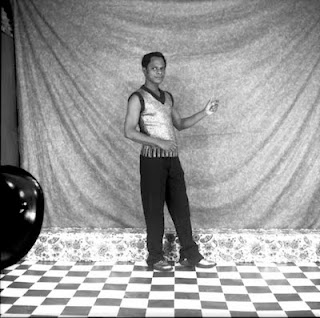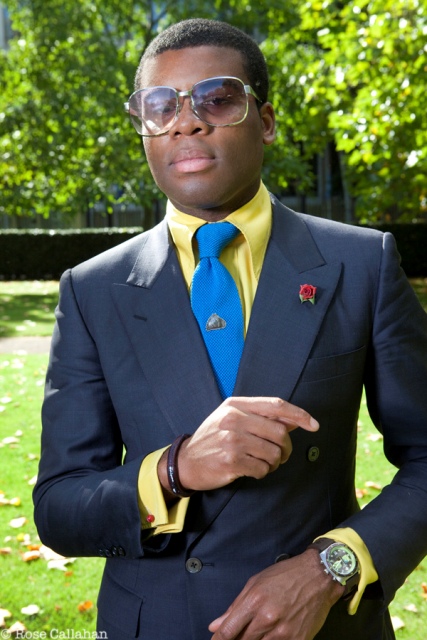Yes, that's correct. I want to look like a plantation owner. Actually, I want to own a plantation. That's exactly why I want a white suit. My superiority complex must be indulged in the face of racial sensitivity, the stares of children and dry cleaning bills
Speaking of children, for a great many of us growing up in Britain of the 1980s and early 1990s, this venerable institution below was our initiation into the intractable allure that a white suit holds. I write of course, of The Man From Del Monte, a tastemaker so prepotent that he could even subjugate
Doctor Who 's definitive leading man into performing his narration:
Of course, I'm quite willing to settle for off white or that light shade of beige that old people favour for upholstery
Now, I've thought about styling one in a variety of forms. I've even considered ensembles in a Tony Montana or
Miami Vice-like vein; utterly germane when matching the large quantities of Bolivian Marching Powder that line one's drawing room. And therein lies a decent line of approach - pastel shirting is an easy gateway to the fun of sporting white suiting - The King of Pop, for one, wrung an enduring image out of
royal blue silk and barely-noticeable pinstripes. I do, however, recommend practically any colour other than darker purple - it's a touch too hard on the eyes, really:
Frankly, Mr. Jagger, this is not one of my favourites. But then, Mr. Watts has been consistently putting you to shame since the 1970s hit their middle period
Nevertheless, Jagger has hit on another interesting aspect - bold shirts and white suits do not necessarily require neckwear; the tropical mode the look connotes makes for a particularly dégagé air; nothing speaks of summer's bright delights like a shirt that brings to mind the concentrated colouring of a particularly punchy cocktail. It's the dressing incarnation of optimism
If one is particularly insensible or talented, a print shirt, worn in the
Tynan fashion, is a step in a similar direction, and these are widely available, from H&M and Topman to
Holliday & Brown, Gucci and Prada. The neckwear possibilities for these are a little looser than their pastel cousins - where the latter works best with plain or subtly patterned neckties and bow ties in both contrasting and similar shades, the former allows one to fool around with clashing prints or adventurous textures like raised ribbing and dupioni (both types may also support a
neckscarf, where bravery permits). Worn at a function, it's an aesthetic that suggests one has brought all of the fun pills to the party. In the best potential interpretation of that hypothesis, of course
So, how about a fellow who dons them habitually? Someone who did not earn the word "iconic" by making himself unavoidable via
Jersey Shore, perhaps. A fellow who has been renowned for almost 40 years, who has designed garments of exquisite grace and idiosyncrasy, who challenges the Beastie Boys' Mike D for the sobriquet, "Man of Leather"
Behold, The Last Emperor himself, Valentino Garavani:
In contrast to rock'n'roll theatricality and dandyish offhandedness, Signor Garavani hews to the side of propriety and age-appropriate formality through simple, sedate accessorising to go with his uniquely Continental manner of quiet authority. Soporific to write about this may be, but for some, the mere act of donning a white suit is a statement in itself. Indeed, this approach makes the suit particularly safe for the city, whereas the playful version has a wider, wilder adaptability. Do not ever let it be said that I cannot cater for
more conservative approaches
Seemingly every neo-haberdashery, designer shop and department store proffer white suits each spring and summer, be it Banana Republic, Hackett, Zara or Ralph Lauren. The choice is very much the preserve of the buyer; my tastes are fairly easygoing and also dependent on fabrics,with one or two caveats - some enticing takes by Tom Ford in his Gucci days aside, I would preferably wear a double breasted version if it were silk. And in the discussion of linen vs. cotton, I'm with cotton - with less of a propensity to wrinkle heavily, it tends to suit three buttons and three pieces more neatly
Did I mention that they go very well with Panama hats? In this case, I do recommend any hatband colour for one's straw, as long as it is not black
Here are my three favourite white/light suit examples:
Barry Sainsbury, former director of the iconic Mr. Fish design boutique, in a summer ensemble complete with Fish's signature same fabric shirt and tie





















































